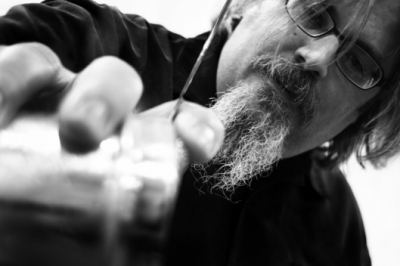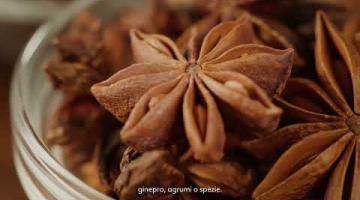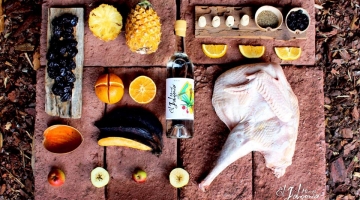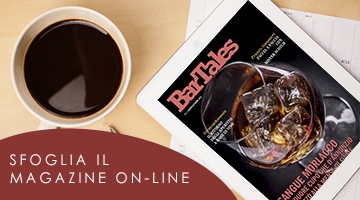In 2007, when David Wondrich’s seminal exploration into American cocktail history Imbibe! was published, there were maybe a half-dozen craft cocktail bars in New York City, rye whiskey was scarce, orange bitters were hard to come by, and absinthe was nonexistent in the U.S. Eight years later, every New York neighborhood seems to have a dozen cocktail spots of its very own. Rye and absinthe are plentiful, and little bottles of bitters are perhaps too plentiful. The time is ripe, then, for a second edition of Imbibe!. A new, expanded volume, now 50 pages longer and with many sections rewritten, will be released tomorrow, April 7. It contains more information about the histories of the sazerac, the julep, the pisco sour and other drinks, plus additional biographical information on Jerry Thomas, the 19th-century bartender who is regarded as the father of modern mixology, as well as the forgotten celebrity barkeeps who came before him. Wondrich sat down with Robert Simonson to talk about what’s new in the book, as well as in the cocktail renaissance it helped inspire:
Robert Simonson: How soon after Imbibe! came out did you realize a second edition would be required at some point?
David Wondrich: About three weeks. [Laughs] I’m not kidding. A guy by the name of Gary Gillman sent me a newspaper article he had found from a database I hadn’t heard of, and it was a review of Jerry Thomas’s second book. I’d heard rumors of his second book, but this was a detailed review. From that review I was able to check it against this book I had, by the name of Charles Campbell, that I had had to transcribe at the Bancroft Library in Berkeley, because they wouldn’t let me photograph it or anything. There are only two known copies. All of a sudden there’s this review, and it’s quoting from Jerry Thomas’s introduction, and I’m going, "Wait a minute. I’ve read that before." I go and look at the Charles Campbell book and it’s verbatim taken from Jerry Thomas’s book. And the names of the drinks, nine out of ten that the review named from the Thomas book are in the Campbell book. Clearly somebody pirated the Thomas book. That gave me a lot more drinks from Jerry Thomas. I ended up not including a lot of them, but I included a few.
There’s a new anecdote about Thomas signing up for a cross-Atlantic hot-air balloon trip. That sounded nuts.
That’s the best thing I’ve found. A week after his obituaries, the New York World sent a reporter around to all the old sports who knew him to do an appreciation of his life. And it also included the story about why his 1860 bar went broke. On the strength of that, I found a picture of that bar.
There’s also new information on his final New York bar, which had billiard tables, bowling alleys, and a shooting gallery. It sort of sounds like he was throwing anything against the wall by then to see what would stick.
At that point, yes. At the same time, even when that bar opened, when he was still popular, he still had things like a life-size statue of himself there and a double-life-size painting by Thomas Nast of him mixing drinks. So it was a pretty lively place.
You have also uncovered a lot more information on the star bartenders who came before Thomas. Did that information alter your ideas about the state of drink-making in the early 19th century, or your ideas about Thomas’s accomplishments?
Absolutely. That was really the hard part of the book, pulling that stuff together and working it into the text without starting from scratch. I finally managed to get enough on the earlier bartenders that I could do a little genealogy on the people who came before, who really built the art of mixing drinks. You can really narrow the big change down to 1840, when suddenly there are lots of fancy drinks. Before that you had a few simple drinks.
Your section on spirits in the original edition was almost a eulogy. “This is no longer available; that is no longer made,” etc. That’s all changed in the past eight years. Did you expect such a revival of lost spirits back in 2007?
I expected no revival. Things were still going down. We had recently lost genever. Craft distilling, in 2007, there were a couple places, but there weren’t a lot. I hoped somebody would do something. I was not confident.
But soon, innovative importers like Eric Seed started coming to you and asking, “What do we need? What should I get?”
And that was great, because I got to inflict my tastes on everybody. [Laughs]
You’ve actually participated in reviving a number of these spirits. Did Imbibe! inspire distillers to reach out to your directly?
I know it did. It helped Bols make the decision to reenter the market and put out Bols genever, a really high-quality, rich-tasting genever. And Eric Seed talked to me about rum and out of those conversations we got Smith & Cross, which I can’t live without.
There’s new material on drinks in the new book, particularly the history of the Julep, which you say is a much older drink than previously thought.
It’s a much earlier drink. In 1770, in Virginia, there are two solid references to the julep being a recreational drink. That’s a big deal, I think. I had looked at the part on the julep in the original edition and I was shocked and disappointed. I wrote almost nothing about it. I wanted to kick myself, because that’s the most important drink.
You call it the “first true American drink.”
It’s a foundational drink. It’s how we started to be different. The mint julep is also the only drink that I’ve championed that hasn’t been revived yet.
Really? People make nice mint juleps at many places.
Some. Not so much. Nobody really specializes in them. People will make them if you ask.
And it was a brandy drink originally?
In the 1700s, it was a rum drink. The Revolutionary War years and a little after, a whiskey drink. Once the country got rich again and started making money again, it was a brandy drink, up until the Civil War.
Can we say it was originally a Virginia drink?
That seems to be the case. But I think it was [bartender Orsamus] Willard at the City Hotel in New York who popularized the iced version.
There are some old drinks you discuss in the new edition that weren’t in the first. How did you decide which drinks to include?
I wanted drinks that were fun and different in part. Also, I wanted to make the book a little more global, along the lines of Thomas’s stated intention that it would be a drinks-of-the-world book. I wanted to flesh it out with drinks that were popular around the world that were current in the period up until Prohibition. So I put in a chapter on swizzles. I put in the St. Martin cocktail from Argentine and Uruguay. I put in the pisco sour. A Peruvian journalist found an early spectacular recipe for the pisco sour that completely upends the history of the drink. I added the Presidente, because that turns out to be a pre-Prohibition drink. My friend Fernando Castellon from France had done some research in the Cuban library and he found the first Cuban cocktail book from 1915 and sent me the recipe from that.
Wondrich, presumably contemplating the nature of bitters.
Photo: Doron Gild
Imbibe! is now regularly referred to as a sort of textbook for budding mixologists. How do you feel about that? Is that what you intended?
I kind of hoped that would be the case. I didn’t expect it. I wrote it with a secret eye toward bartenders. I thought it would be useful for bartenders to have the original recipes, because I saw bartenders were arguing a lot about the history of things. So I thought, Let’s try to set a baseline here. Rather than put my recipes in, I’m going to give you the oldest good recipes for these drinks, verbatim.
Have you seen the book interpreted by bars and bartenders in ways you didn’t expect?
[Laughs] Yeah. I’ve seen a lot of people referring on their menus, “Such and such according to David Wondrich’s Imbibe!” and it has absolutely nothing to do with what’s in the book.
You mention in the new edition that absinthe is one of the great success stories of the cocktail revival. What are some of the other ones, in your opinion, either in terms of spirits, old cocktails revived, or old practices brought back?
So much has changed. Old Tom gin, genever, rye whiskey, funky rum, rum that tastes like rum, a bunch of liqueurs have come back, new interest in orange curacao …
A million brands of bitters …
Oh, god. A million and a half, even. A little too much energy in bitters. Bitters don’t require a still, so everybody’s happy to make bitters. Bitters are the vodka of the craft cocktail world. Anyone can make it. Procedures? Making Blue Blazers, people do that; carving ice into balls. I’m not taking credit for all these things. I think Imbibe! was a catalyst for things that were already in the air.
In 2007, there were a handful of good cocktail bars in the county. Now there are hundreds. Have we reached saturation? Is there such a thing as too many cocktail bars?
Well, maybe in New York City. Other places, there’s still room. The main cities might be saturated.
Do you think there is more that bars could be doing to distinguish themselves from one another?
I absolutely do. You must think that as well. There’s a kind of generic model of craft cocktail bar. In their mind, they think it’s modeled on a speakeasy, but really it’s an early-1950s cocktail lounge. Soft lighting, soft music, darkness, elegant service, strong drinks. That’s one model of bar. But I was recently at Prizefighter in [Emeryville, California], which is a big open place with a nice big patio. I like that bar. It really presents a different model of the neighborhood hang as cocktail bar.
You mentioned the speakeasies. That was one of the biggest trends in bars over the past several years, though it seems to be dying out. With this industry’s deep interest in the past, there have been various attempts to recapture a certain time and place in drinking history. A bar like Dead Rabbit, with its 1850s ambience, is an example of that. Are such excursions worthwhile or are we entering theme-park territory here?
At its wilder edges you’re in theme-park land. On the other hand, you can always get a good drink there. You don’t necessarily have to drink what’s on the cocktail list. I’d rather have them than not have them. Given time, a lot of them will evolve into wonderful things. That’s the missing ingredient. It’s like whiskey. A bar needs aging to come into its own and build its own culture.
A common lament I hear among the old guard of cocktail people is that bartenders run before they can walk. They experiment and riff on classics before they get the classics right. Do you think that?
I definitely see that. I see a lot of cocktails that are trying a little too hard to be noticed, rather than to be delicious. On the other hand, people drink those and seem to like them. I think my tastes may be a little old-fashioned. I find them a little challenged and awkwardly balanced. But other people suck them right down.
In doing research about cocktail history, I’m always struck about how every seeming innovation of today — barrel-aged cocktails, bottled cocktails, artistically carved ice — was already done at some point in the past. What do you think the cocktail revival has contributed to the art of mixology that’s actually new?
We brought a lot of new ingredients into things. The Italian amari — that was only touched on before. The molecular stuff is definitely new, some of it anyway. Things like clarified juices aren’t new. We had clarified milk punch in the 18th century. But some of it is new, it’s just not practical for most bars. It’s like airplanes in 1910. Only a few people would have any interest in flying them. Eventually it got a lot more accessible. I think that might be the case for some of these inventions. Somebody will come up with a centrifuge for the bar that will be affordable and idiot-proof.
That person would probably be Dave Arnold.
Most likely.
Speaking of Dave Arnold, what do you think of bars like Booker & Dax and Aviary, which serve fine drinks, but go to great technical lengths to create them? Are their processes worth the effort?
When I’m sitting at their bar, I think it is. Those bars are kind of unique. Another one is 69 Colebrooke Row in London. That one’s particularly unpretentious, but so is Booker & Dax. Aviary, I would say it’s pretentious, but I don’t mean that as an insult, because it delivers on what it portends to do. It’s fine dining for cocktails, which is not something we’re used to. But it’s definitely fun. There are a lot of places that aren’t as successful. Those places have kind of figured it out.
The boom in cocktails has also led to a vast increase in opportunities for bartenders. They get book deals, are seen on television, are flown all over the world to participate in and judge contests, become celebrities in their own way. So we have the peripatetic bartender as opposed to the bartender who’s always behind the bar. Is that a good thing, a bad thing?
I suspect it’s a little bit of both. It’s bad when you go to their bar and they’re not there and you went there to see this personality.
I never expect to see the chef when I go to a restaurant. They’re in the kitchen.
No, but the bartender is a different job. The bartender is a face-time job. It’s definitely an issue. On the other hand, from the bartender’s point of view, bartending is punishingly hard work over the long haul. You need to have a career path where you can get out form behind the bar if you want to and need to. If there is that path, you get far better people into the profession. I think the profession benefits from having that path. It just irritates me sometimes as a customer.
You travel all over the world and see bars in various countries. Because of all the cocktail books that are available, the internet, all the means of communication bartenders now have, is the world all starting to make cocktails in the same way?
The top bars are remarkably similar, and there is a kind of global consensus. There’s a reason why these bars are kind of the same. There is a kind of “best practices.” There are regional differences. In London, the drinks are far more theatrical that you would get away with here.
“Drink and a Show.”
Exactly. I think that has to do with their clientele. They get a lot of global money flowing into those bars.
I’ve heard from several British bartenders who regard the New York cocktail bar scene as boring.
They think we’re boring. I think we’re subtle. [Laughs] England has a long theatrical tradition, obviously. In Italy, the drinks are very precise and well calibrated. The Italians are very good at the elegance of service. That’s their thing. The Germans have a big fascination with all things American, and there’s a little bit of rock and roll in all their bars. I would like to see more Italian influence in the bars here. More aperitifs, more outdoor space. I would like to order a drink and have someone bring me a little tray of olives and potato chips with it. You always get these little snacks with every drink in Italy.
Will you continue to research Jerry Thomas’ past?
I won’t stop, anyway. I think I’m reaching the point of diminishing returns.
What unsolved question would most you like to find the answer to? Besides, I mean, where the name “cocktail” really came from?
I would like a look at Jerry Thomas’s second book, obviously. Failing that, I’d like to know what his middle initial stands for. And I actually know where "cocktail" came from, pretty solidly. It’s in the book. Ginger was used in the horse trade to make a horse stick its tail up. They'd put it in its ass. If you had an old horse you were trying to sell, you would put some ginger up its butt, and it would cock its tail up and be frisky. That was known as “cock-tail.” It comes from that. It became this morning thing. Something to cock your tail up, like an eye-opener. I’m almost positive that’s where it’s from.
thanks to :http://www.huffingtonpost.com/tony-sachs/post_9243_b_6980700.html
















